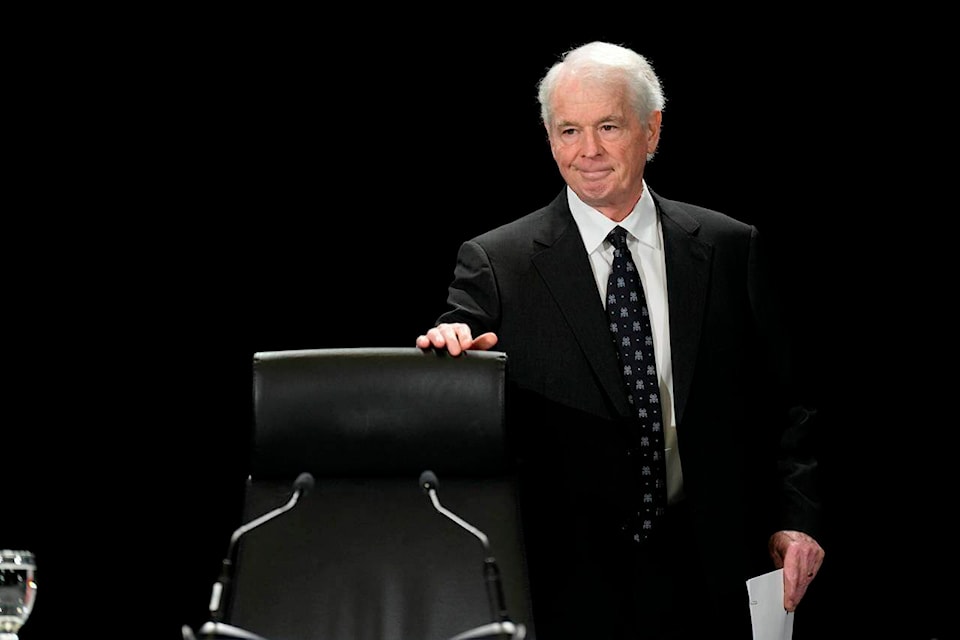When the federal government invoked the Emergencies Act in February 2022, it created several extraordinary powers hoping to clear protests entrenched in Ottawa’s downtown core and at border blockades spotted across four provinces.
Among the tasks assigned to the Public Order Emergencies Commission was to examine whether the specific powers the act granted were appropriate and effective.
Here is a brief look at some of those powers and what Rouleau said about them.
1. Regulating and prohibiting public assembly in specific locations, with the power to designate and secure several types of locations including Parliament Hill, official residences, power plants, border crossings, hospitals and COVID-19 vaccine clinics. The government also barred people from bringing specific things into those restricted areas, such as food or gasoline.
What the measure did: It allowed police to force people out of specific locations, such as what became known as the “red zone” around Parliament Hill, as well as keep others from joining or from stocking those already inside the zone with supplies to allow them to stay in place.
What Rouleau said: The commissioner said a ban on participating in public assemblies “directly targeted the most immediate manifestation of the emergency; namely, the protests themselves.”
But he also said it was the measure that most directly affected the constitutional rights of protesters.
Rouleau concluded that banning people from assembling in certain spaces was effective because it was what Ottawa police relied on to create an “exclusion zone” around the city’s downtown. He called that critical to the police operational plan.
He said the government was appropriately careful not to ban all anti-government protests but rather protect designated places. But he said a lack of detail about what constituted a secured location was “problematic” and was concerned the public safety minister could add more places to the list without restriction.
Rouleau also said it could be argued the restrictions should have applied only in Ontario, the one province with large-scale protests still ongoing when the act was invoked.
Describing it as a “close call,” he accepted the federal cabinet was reasonably concerned about protests overstretching police resources across the country.
2. Prohibiting minors to participate in illegal assemblies
What the measure did: Discouraged parents from bringing children to the protests.
What Rouleau said: “These protests were no place for children,” Rouleau wrote.
3. Designate certain services as essential and compel companies providing those services to do so in the protest zones.
What the measure did: For much of the blockade in Ottawa in particular, police said they could not compel tow truck services to help remove trucks. Under the Emergencies Act power, police were able to order companies to tow away vehicles, including big rigs, that were blocking the streets.
What Rouleau said: This was an appropriate measure considering the circumstances, and that likely most, or even all, tow truck operators would have refused to help without being forced to do so.
4. Barring non-Canadians from entering the country to participate in a prohibited protest.
What the measure did: It allowed the Canada Border Services Agency (CBSA) to exclude foreign nationals from entering Canada if they were suspected of coming to join the blockades.
What Rouleau said: There was evidence of international participation in the protests and while this measure had limited use it was reasonable to include.
The report details evidence of protests taking place on both sides of affected border crossings, and about calls originating from the United States flooded emergency 911 call centres in Ottawa during the protests in a bid to tie up police resources.
It also says more than $6 million in funding for the Freedom Convoy protests flowed from the U.S.
During a call with Prime Minister Justin Trudeau in the midst of the protests, President Joe Biden said the situation was a shared problem.
“In this light, it was reasonable to consider that individuals would come to Canada to physically join the protests, and it was appropriate to take measures to prevent this,” Rouleau wrote.
5. Compel Canadian banks and other financial institutions to cease all dealings with individuals “engaged, directly or indirectly, in an activity” deemed illegal under the Emergencies Act.
What the measure did: The accounts of 257 people and businesses were temporarily frozen by financial institutions.
What Rouleau said: The measure was appropriate because the protests in Ottawa protesters were only able to become so entrenched as a result of the supports they were receiving, and blocking access to new funds made it harder for them to keep protesting.
“This likely had at least some impact on the footprint of the protests prior to police enforcement action,” Rouleau said.
He said it was reasonable to prevent protesters from being financially sustained over the long term.
But he concluded the financial measures were applied too broadly, on people who should not have been targeted, because it went beyond the federal government’s intent of targeting assets of only the protest leadership and major supporters.
Rouleau also said there should have been more flexibility to how it was applied in order to create humanitarian exceptions to allow people to make certain purchases.
During inquiry testimony, the commission heard some people had joint-bank accounts frozen and struggled to make payments for prescriptions.
David Fraser, The Canadian Press
READ ALSO: Inquiry: decision to invoke Emergencies Act justified, but ‘regrettable’ it happened
